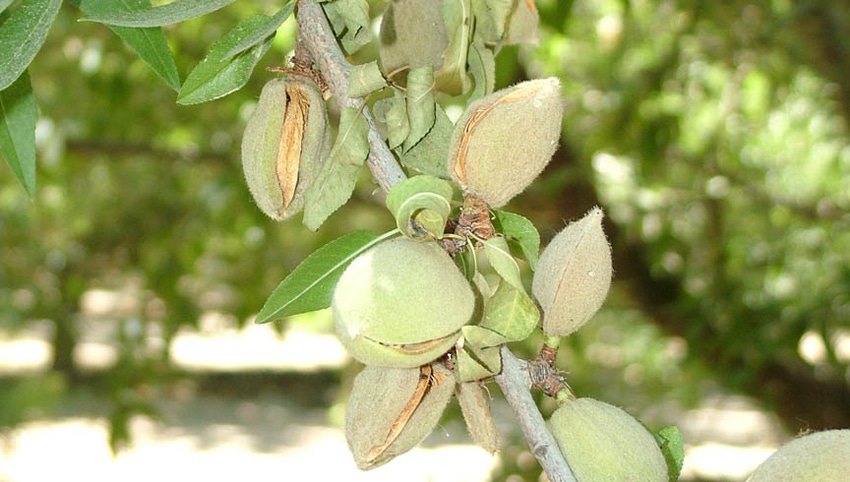
Recent lab test findings show damage to Fritz and other varieties of almonds from a bacterial infection.
Called bacterial spot, the disease was first reported seven years ago by now-retired University of California Cooperative Extension (UCCE) farm advisor John Edstrom.
It’s characterized by amber-colored gum exuding from a lesion, about the size of a pencil eraser on the hull of an infected nut. It has been positively identified in orchards in Merced, Stanislaus and San Joaquin counties in May, mostly on Fritz, a major pollinator variety in California. This damage has also been reported in Monterey and Padre trees. Researchers suspect the disease may be in other areas of the state as well.
Development of bacterial spot is apparently favored by weather conditions similar to those that foster walnut blight. This has been common in California orchards the past several years. Those conditions are characterized by warm rains with temperature ranging between 60 and 75 degrees, notes David Doll, UCCE farm advisor for Merced County.
He and UCCE colleagues, Brent Holtz, San Joaquin County farm advisor; Roger Duncan, Stanislaus County farm advisor, and Themis Michailides plant pathologist at the Kearney Research and Extension Center, Parlier, have been studying bacterial spot.
“If weather conditions that encourage spread of this infection continue over the next several years and growers aren’t able to control it, the disease could become a major concern for California,” Doll says. “This year it’s likely the disease will cause some growers to lose several hundred pounds of almonds per acre. The best case scenario for next year would be to have rain prior to leaf-out,followed by a dry spring. Orchards where the bacterium is present would probably still experience the disease but, hopefully, it would be less severe.”
Still, dry spring weather wouldn’t put a stop to the disease, Doll notes. Once in an orchard, bacterial spot will continue to spread with rain. In Australia, where late spring rains are common, the pathogen has become so aggressive growers there no longer plant Fritz.
“I doubt if we’re at that point yet here in California,” he says. “Our weather patterns are different than in Australia, and I think, in time, we’ll come up with some ways to manage bacterial spot.”
That’s a challenge. Unlike fungal diseases, those caused by bacteria are more difficult to control chemically. Although there’s no evidence that bacterial spot in almonds is spread by the leaffooted plant bug, researchers will be looking closer at that possibility in one of several different field experiments scheduled to begin next year. These trials will also include the use of late dormant copper sprays at bud swell, to reduce overwintering inoculum. That’s proven successful in some Australian orchards, Doll reports.
“The most effective way to manage bacterial spot will probably be good orchard sanitation,” he says. “Infected nuts don’t seem to shake out of the trees. So, growers will need to spend some time removing the mummies.”
He urges growers to learn about the bacterial spot symptoms online at http://www.thealmonddoctor.com and then, if it’s present in their orchards, to contact their farm advisor, PCA or crop consultant to submit a sample for evaluation.
“That will give us a better idea of where the bacterial spot is, the strain of bacterium present, and will help us develop practices to manage the disease,” Doll says.
A UCCE field day is scheduled for July 12 near Ripon, Calif., to highlight what is known currently about this new disease in California’s almond orchards.
This report is from Tree Nut Farm Press, a twice-monthly electronic newsletter published by Western Farm Press during the growing season. This edition was sponsored by DuPont Crop Protection. If would like to receive Tree Nut Farm Press go to the Western Farm Press home page (westernfarmpress.com) and sign up for it and other Farm Press electronic newsletters.
More from Western Farm Press
Farmland values still climbing, but pace slows
What a grocery store without honey bees looks like
EPA’s Pinocchio nose grows with farmer privacy scandal
5 lessons from the Honeygate scandal
About the Author(s)
You May Also Like




